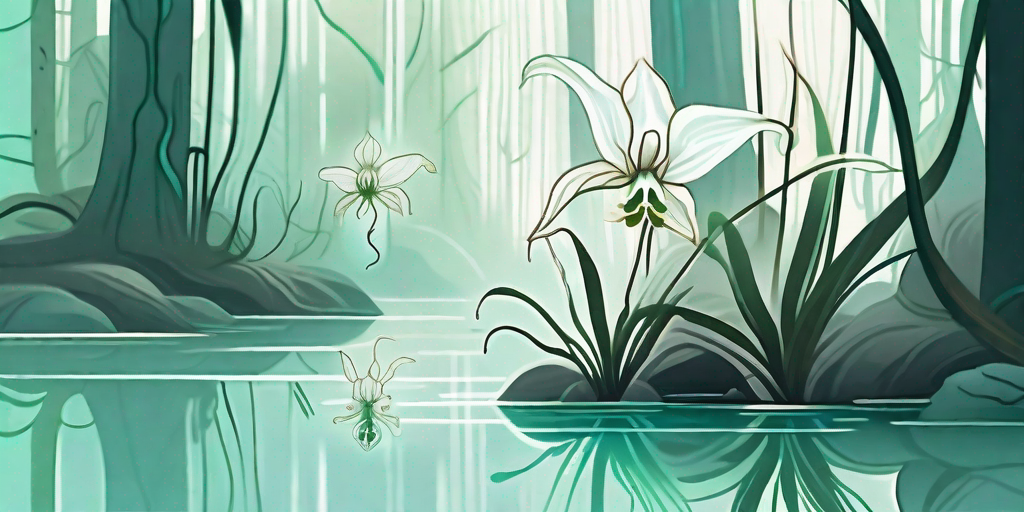
Welcome, dear reader, to the captivating world of rare flowers, where we are about to embark on a thrilling journey to uncover the mysterious beauty of the Ghost Orchid. This elusive flower, with its ethereal charm and intriguing history, has been the subject of fascination for botanists, photographers, and flower enthusiasts alike. So, buckle up, and let's dive into the enchanting world of the Ghost Orchid!
The Ghost Orchid: A Spectral Beauty
With a name like Ghost Orchid (Dendrophylax lindenii), one might expect a spooky tale, but fear not! The Ghost Orchid is named for its ghostly appearance, not for any supernatural tendencies. This rare flower is a leafless epiphyte, meaning it grows on other plants, and its roots blend in with the host tree, making the flower appear to float in mid-air like a specter. Quite the dramatic entrance, wouldn't you agree?
But the Ghost Orchid doesn't stop at dramatic entrances. It also has a penchant for playing hard-to-get. This elusive flower blooms only under specific conditions and for a short period, typically between June and August. And when it does bloom, it's a sight to behold. The flower, with its long, slender petals and striking white color, is a spectacle of nature's artistry.
The Ghost Orchid's Secret Hideouts
Like any good specter, the Ghost Orchid is a master of hide-and-seek. It's native to Florida, Cuba, and the Bahamas, but even in these places, it's notoriously difficult to spot. In Florida, for instance, it's found primarily in the Fakahatchee Strand Preserve State Park, a swampy forest that's not exactly a walk in the park.
And if you're thinking of going on a Ghost Orchid hunt, you might want to pack your climbing gear. These flowers prefer to grow high up on the trunks of trees, often out of reach of prying eyes and eager hands. But don't let this deter you. The thrill of spotting a Ghost Orchid in its natural habitat is well worth the effort.
Unraveling the Ghost Orchid's Mysteries
Now that we've covered the basics, let's delve deeper into the Ghost Orchid's mysteries. This flower is not just a pretty face; it's also a fascinating subject of scientific study.
One of the most intriguing aspects of the Ghost Orchid is its pollination. Unlike many flowers that attract a variety of pollinators, the Ghost Orchid is exclusively pollinated by the Giant Sphinx Moth. This moth, with its long proboscis, is one of the few creatures capable of reaching the flower's nectar, tucked away at the end of a long, narrow spur.
The Ghost Orchid's Survival Tactics
The Ghost Orchid's relationship with the Giant Sphinx Moth is a classic example of co-evolution, where two species evolve in response to each other. But this isn't the only trick up the Ghost Orchid's sleeve. This flower is also a master of survival.
Remember how we mentioned that the Ghost Orchid is leafless? This isn't just for show. By forgoing leaves, the Ghost Orchid reduces its surface area, minimizing water loss and allowing it to survive in its dry, harsh habitat. It's a clever strategy, and one that's served the Ghost Orchid well over the years.
FAQs about the Ghost Orchid
-
Why is the Ghost Orchid so rare?
The Ghost Orchid's rarity is due to a combination of factors. Its specific habitat requirements, short blooming period, and reliance on a single pollinator all contribute to its scarcity. Additionally, habitat loss and illegal collection have further threatened its population. -
Can I grow a Ghost Orchid at home?
While it's technically possible to grow a Ghost Orchid at home, it's extremely challenging due to the flower's specific needs. It requires a particular host tree, specific temperature and humidity conditions, and even its own personal Sphinx Moth for pollination. So, unless you're an experienced orchid grower (or a Sphinx Moth whisperer), it might be best to admire the Ghost Orchid in its natural habitat. -
Is it illegal to pick a Ghost Orchid?
Yes, it is illegal to pick a Ghost Orchid in the wild. The Ghost Orchid is a protected species, and removing it from its natural habitat can result in hefty fines and even jail time. So, if you're lucky enough to spot one, take plenty of pictures, but leave the flower where it is.
Conclusion
And there you have it, the mysterious beauty of the Ghost Orchid unveiled. This spectral flower, with its elusive nature and captivating charm, truly is a marvel of the botanical world. So, the next time you find yourself in a swampy forest in Florida, keep your eyes peeled. You never know, you might just spot a ghost... Orchid, that is!
Until our next botanical adventure, happy flower hunting!















